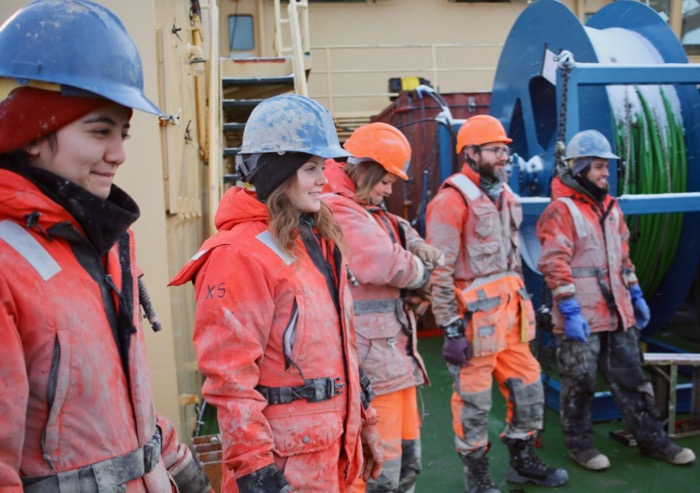Another Day, Another Core
Unlike the Kasten core, which is a single 3-meter long barrel, the megacore has 12 short tubes.
 The megacore rig is loaded with 12 empty tubes, each designed to collect up to 60 cm of sediment from the seafloor. Amundsen Sea, Antarctica.
The megacore rig is loaded with 12 empty tubes, each designed to collect up to 60 cm of sediment from the seafloor. Amundsen Sea, Antarctica.
Each tube has the potential to capture up to 60 cm of water and sediment right at the seafloor - many of the researchers here are interested in studying that sediment-water interface.
 Dr. CD Hillenbrand holds a megacore tube filled with a sediment and sea water sample. Photo courtesy of Peter Kaple.
Dr. CD Hillenbrand holds a megacore tube filled with a sediment and sea water sample. Photo courtesy of Peter Kaple.
The 12 tubes are loaded into the megacore rig and it is lowered off the stern of the ship with the same winch that is used for the Kasten core.
 Marine techs Rich Thompson and Chuck Holloway guide the megacore array off the deck of the Nathaniel B. Palmer.
Marine techs Rich Thompson and Chuck Holloway guide the megacore array off the deck of the Nathaniel B. Palmer.
Depending on the water depth, it can take over an hour to send the megacore down to the bottom and bring it back up. The researchers don their safety gear and head out on deck to detach the new samples from the rig once it is back onboard.
 Asmara Lehrmann, Rachel Clark, Elaine Mawbey, Ali Graham, and Santi Munevar wait for the megacore array to be secured before moving in to collect samples.
Asmara Lehrmann, Rachel Clark, Elaine Mawbey, Ali Graham, and Santi Munevar wait for the megacore array to be secured before moving in to collect samples.
Each tube has a shutter at the bottom which is triggered to close when the full core lifts off the seafloor – sometimes not every core closes. In this video (courtesy of Santi Munevar), 10 of 12 tubes were sealed and now contain a sediment sample. The shutter did not close on the other two.
Video by Santi Munevar:
Before a megacore tube can be brought inside, it has to be detached from the rig – and to do that, the shutter that is holding in the cylinder of sediment has to be replaced with a thick rubber stopper called a bung. This invariably requires someone to lie down on the deck in a muddy puddle of ice cold water and attempt to shove a stopper into a tube of mud that is working with the force of gravity to spill out everywhere. Also, often when you shove the bung into the bottom, seawater spills out the top of the tube, typically soaking the person trying to insert the bung. Bunging is the number one reason people’s safety gear looks like they rolled in dirt at some point on this expedition (because they kind of did).
 Asmara Lehrmann works to insert a bung into the bottom of a megacore tube while Rachel Clark holds the tube in position.
Asmara Lehrmann works to insert a bung into the bottom of a megacore tube while Rachel Clark holds the tube in position.
Megacore tubes that have been bunged and capped are placed in a carrying case to be brought inside.
 Megacore tubes ready to be brought inside for sampling sit in a wooden storage box. Photo courtesy of Peter Kaple.
Megacore tubes ready to be brought inside for sampling sit in a wooden storage box. Photo courtesy of Peter Kaple.
One of my favorite things to do is to inspect the water-sediment interface for signs of life - this is where we discovered Bruce the Antarctic Sea Anemone.
 Occasionally, animals are seen at the water-sediment interface, such as this Antarctic sea anemone captured in a recent megacore of Cranton Bay.
Occasionally, animals are seen at the water-sediment interface, such as this Antarctic sea anemone captured in a recent megacore of Cranton Bay.
We then begin processing the core samples by slicing off one centimeter of sediment at a time and placing each slice in its own baggie.
 Teamwork makes the dream work when it comes to processing a megacore sample, dividing the sediment up into 1 cm slices. In the foreground, from left to right are Santi Munevar, Elaine Mawbey, and PolarTREC educator Sarah Slack.
Teamwork makes the dream work when it comes to processing a megacore sample, dividing the sediment up into 1 cm slices. In the foreground, from left to right are Santi Munevar, Elaine Mawbey, and PolarTREC educator Sarah Slack.
Santi Munevar pulls the core tube down to reveal 1 cm of sediment, which Elaine slices off using “Mr. Slicey” and Rachel catches in a plastic bag. A typical core is 40 cm long, so when all 12 tubes successfully trigger and are filled, it can take a while to process all of them. The majority of these samples will be shipped to different research institutions at the end of this expedition.
 Elaine Mawbey, Santi Munevar, and Rachel Clark bag up a 1 cm section of sediment captured in a megacore.
Elaine Mawbey, Santi Munevar, and Rachel Clark bag up a 1 cm section of sediment captured in a megacore.
Megacore!!


Comments
Add new comment